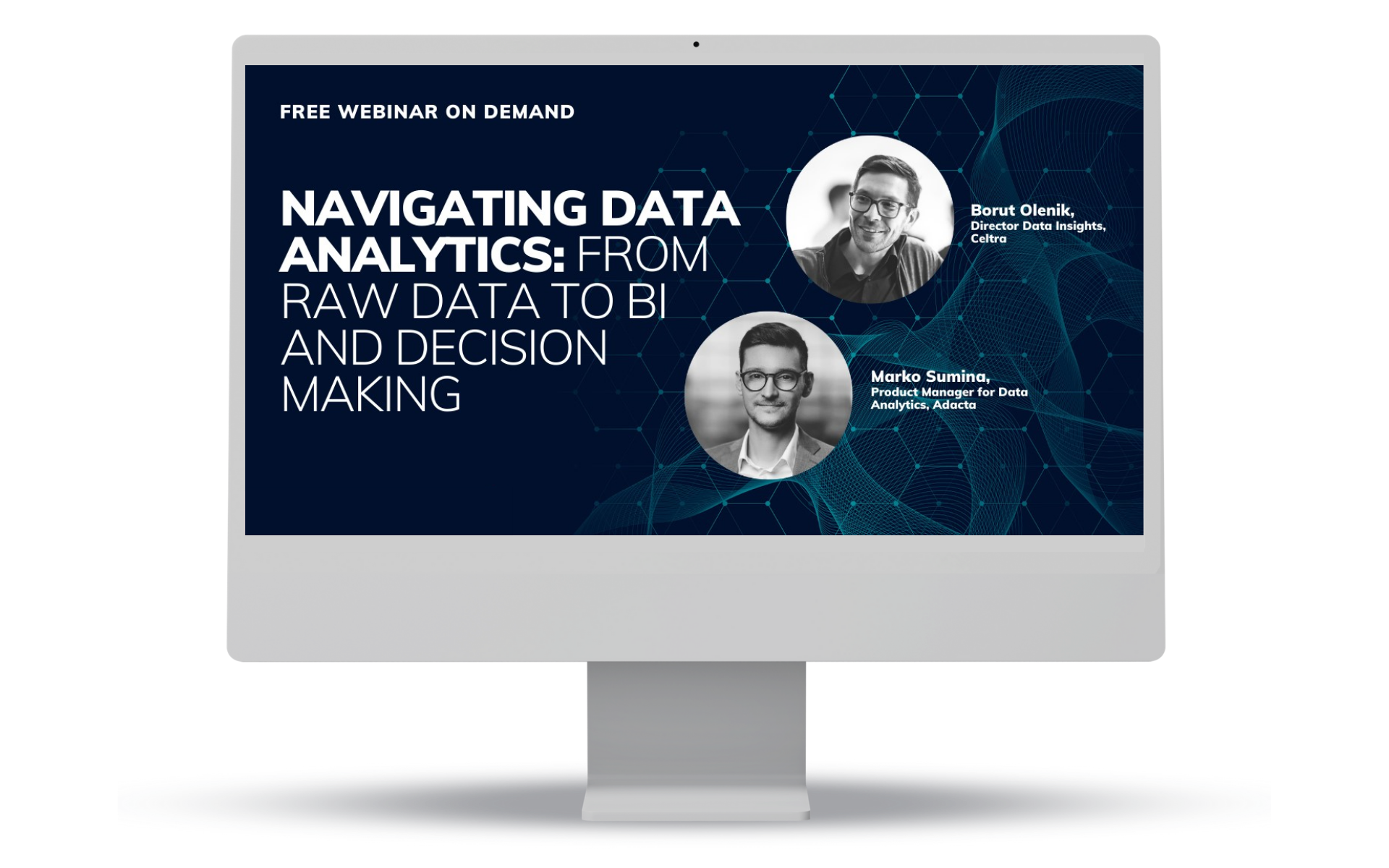
Insights from Adacta's Webinar: Leveraging Data Analytics in the Insurance Industry
The digital age has changed the insurance industry, not just in terms of product offerings, customer interactions, and building competitive advantage via technology, but also in how we interpret vast amounts of data. At Adacta, we've always been at the forefront of embracing change, ensuring that our clients and partners benefit from the latest technological advancements.
We recently hosted a webinar led by our VP for Business Development, Alexander Solomonov, delving into the significance of data analytics in the insurance sector with guest speaker Borut Olenik, Director of Data Insight at Celtra and Adacta’s Product Manager for Data Analytics, Marko Sumina.
Table of Contents:
- Why is Data Analytics Crucial for Insurance business?
- Journey Through Data Analytics with Borut Olenik
- Marko Sumina’s Insights on Adacta’s Data Capabilities
- Closing thoughts
Why is Data Analytics Crucial for Insurance business?
The insurance industry, like many others, is witnessing exponential growth in digital data. To effectively navigate this influx and make sense of it, data analytics becomes indispensable. It helps insurers make informed decisions, optimize operations, trim unnecessary costs, and refine processes, eventually leading to strategic development and improved performance. Yet, a study from Quantum Black AI by McKinsey reveals a stark disparity: while a handful of companies enjoy up to 25% profit boosts through tech-driven data analytics, a staggering 86% of insurance companies are grappling with its challenges.
Journey Through Data Analytics with Borut Olenik
Mr. Borut Olenik, Director of Data Insight at Celtra stressed at the very beginning that successful data analytics requires alignment with overarching business goals and strategies. It isn’t just a sideline activity but should be interwoven with every decision-making process.
Olenik's analysis of the data journey showcased its four main levels:
- Descriptive: Understanding what transpired.
- Diagnostic: Delving into why it happened.
- Predictive analytics: Foreseeing what's on the horizon.
- Prescriptive: Deciding the best course of action.
Olenik emphasized that embarking on this journey means starting with the basics, understanding past events, and only then venturing into the realms of machine learning and Artificial Intelligence. Further, he underscored the importance of a well-architected and scalable data analytics framework, which evolves from raw data to actionable insights.
Marko Sumina´s Insights on Adacta´s Data Capabilities
Adacta's Product Manager for Data Analytics, Mr. Marko Sumina, shifted the conversation towards the practical application of advanced data analytics in Adacta's award-winning software, AdInsure. He highlighted the imperative of beginning with pristine data quality and then integrating it for various use cases.
Showcasing AdInsure's capabilities, Sumina revealed its seamless integration with Power BI, facilitating detailed analytics tailor-made for different stakeholders in the insurance industry, be it agents, brokers, or executives.
Sumina ended his presentation on a high note with an introduction to advanced analytics and machine learning functionalities within AdInsure. The system's prowess in detecting anomalies in the claims process and enriching the customer journey during the insurance policy process is a testament to the game-changing potential of integrating Artificial Intelligence across the insurance value chain.
Closing Thoughts
As the webinar wrapped up, a central theme emerged: successfully harnessing data analytics in insurance requires a cohesive strategy. This encompasses tracking pivotal KPIs, optimizing operations with machine learning, and elevating customer experiences through data-derived insights.
At Adacta, our mission remains steadfast: to ensure our partners in the insurance market can efficiently utilize insurance data analytics for their benefit. We believe in the power of data-driven decisions, and through forums like this, we aim to share our knowledge and drive the industry towards a data-enriched future.






